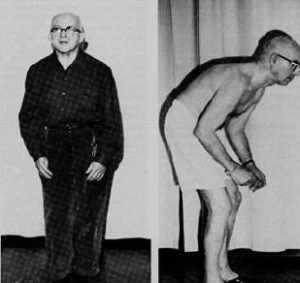

MedFriendly®


Rigidity
Rigidity means hardness, inflexibility, or stiffness.
Rigidity occurs due to increased tone (tension) in
muscles near a joint that are in a shortened state
(known as agonist muscles) and muscles that work to
oppose such shortening (known as antagonist
muscles). Rigidity can affect any part, but usually
affects the arms, legs, hands, feet, neck, shoulders,
hips, and the abdomen. Rigidity can easily be elicited
upon physical examination by trying to move the
affected body part (e.g., arm or leg) back and forth.
Upon doing this (even at low speeds) the affected body
part will be more difficult to move than an unaffected
body part (e.g., opposite limb).
A person with rigidity due to
Parkinson's disease.
FEATURED BOOK: Parkinson's Treatment: 10 Secrets to a Happier Life
Sometimes, rigidity occurs throughout the whole range of movement of the affected body
part. This is known as lead pipe rigidity. In cogwheel rigidity there is a jerky intermittent
resistance to passive movement as the muscles tense and relax. Another manifestation
of rigidity is spasticity (involuntary muscle contractions). This is often seen in upper motor
neuron paralysis. Upper motor neuron paralysis is a type of paralysis (loss of movement
and/or sensation) that is due to injury or damage in the brain or spinal cord.
Sometimes, stiffness can occur due to muscle disuse (or minimal use) from decreased
conditioning. Rigidity of the back muscles is common in many people after back injuries.
"Where Medical Information is Easy to Understand"™
Muscle rigidity is often seen in Parkinson's disease (a type of brain
disease resulting in motor impairments). In Parkinsonís disease,
rigidity often occurs initially in the shoulder, along with pain. Axial
rigidity can also occur on Parkinsonís disease, which is rigidity of
the neck and trunk. This can cause the spine to curve and/or a
stooped over posture, which causes further rigidity.
Rigidity can also occur as a result of severe traumatic brain injuries
and cerebral palsy. Cerebral palsy is a type of brain damage that
occurs during pregnancy, during birth, during infancy, or during early
childhood that causes the child to have difficulties with movement
and posture.
Another example of rigidity is spastic gait. Spastic gait is an abnormal type of gait (way of walking) in
which the legs are weak and stiff, and in which there is no flexing at the knee and ankle. After death, the
body is also known to become rigid.
Rigidity also refers to a personality aspect that is resistance to change. This is sometimes referred to as
stubbornness or being obstinate. Such a person typically refuses to appreciate another personís views
(lack of empathy). Rigidity comes from the Latin word "rigere" which means "to be stiff."















